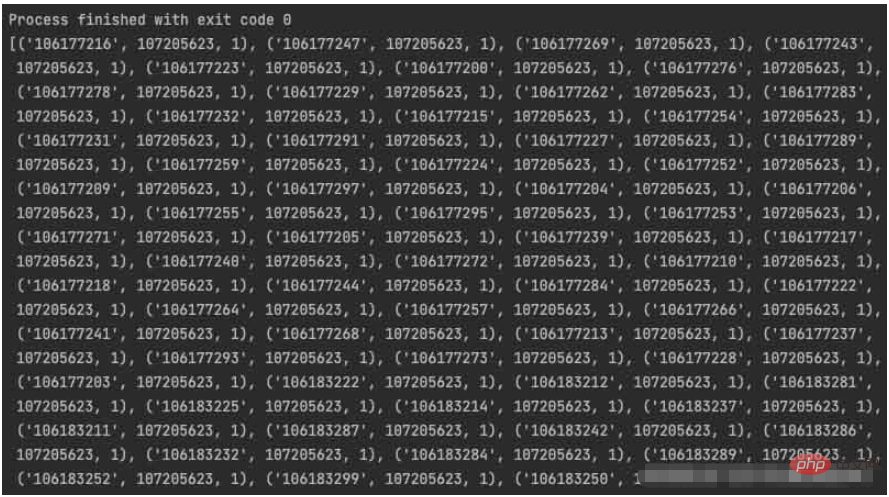python之怎麼使用執行緒池map()方法傳遞多參數list
線程池map()方法傳遞多參數list
之前透過threading.thread()進行了助力介面的多執行緒並發,但是這個針對並發數量較少的時候比較好用,如果並發數量多,除了線程包協程這種處理方式的情況下,我們還可以採用線程池的方法。
線程池的實作通俗講就是把所有的任務放在了訊息佇列裡,開啟多個執行緒後執行線程,但執行緒執行結束後不會中斷執行緒任務,會從訊息佇列內繼續取得執行緒任務進行執行緒執行,這樣執行緒池就比多執行緒操作節省了許多創建執行緒與關閉執行緒的步驟,節約大部分資源與時間。
執行緒池並發需要引入模組
import concurrent.futures
ThreadPoolExecutor 內有兩種執行緒池方法map()與submit()今天先說map()方法
#他的語法為
with concurrent.futures.ThreadPoolExecutor() as pool:
res = pool.map(craw, uid_list)
print(res)map()內craw為方法名,這裡方法命不帶()uid_list為方法參數,map()方法內需要傳遞list資料型別
#先看整體程式碼
##5000用戶並發助力 def test_case_09(self):
"""5000用户并发助力"""
# 通过yaml配置文件封装方法 获取uid_list
uid_list = YamlHandler(YamlThePath().number_new).get_uid_list()
# add_ticket获取5000账号登陆状态
with concurrent.futures.ThreadPoolExecutor() as pool:
pool.map(AccountAccess().add_ticket, uid_list)
# 5000账号线程池方法助力用户
with concurrent.futures.ThreadPoolExecutor() as pool:
pool.map(PreheatMethod().help, [(uid, self.A, 1) for uid in uid_list])
# 获取用户被助力次数
response = PreheatMethod().init(self.A)
print(f"当前用户被助力次数 :{response['data']['userInfo']['helpedCount']}次") def add_ticket(self, uid):
"""
获取单独用户t票
:param uid: 单独用户uid
:return:
"""
self.data['url'] = ApiAddress().get_ticket
self.data['host'] = ApiAddress().host
self.params['uid'] = str(uid)
self.params['type'] = 0
self.data['params'] = json.dumps(self.params)
res = r().post(url=ApiAddress().ticket, data=self.data)
print(f'获取t票结果:{uid}{res}')
return uid def help(self, agrs):
"""
助力用户
:param agrs: uid:当前用户uid to_uid:助力用户uid count:助力次数
:return:
"""
uid, to_uid, count = agrs
self.attrs['toUid'] = str(to_uid)
self.attrs['count'] = count
response = r().response(uid, self.code, "help", **self.attrs)
logger.info(f'help response uid:{uid} to_uid:{to_uid}\n{response}')
return responsewith concurrent.futures.ThreadPoolExecutor() as pool:
pool.map(PreheatMethod().help, [(uid, self.A, 1) for uid in uid_list])[(uid, self.A, 1) for uid in uid_list]

以上是python之怎麼使用執行緒池map()方法傳遞多參數list的詳細內容。更多資訊請關注PHP中文網其他相關文章!

熱AI工具

Undresser.AI Undress
人工智慧驅動的應用程序,用於創建逼真的裸體照片

AI Clothes Remover
用於從照片中去除衣服的線上人工智慧工具。

Undress AI Tool
免費脫衣圖片

Clothoff.io
AI脫衣器

Video Face Swap
使用我們完全免費的人工智慧換臉工具,輕鬆在任何影片中換臉!

熱門文章

熱工具

記事本++7.3.1
好用且免費的程式碼編輯器

SublimeText3漢化版
中文版,非常好用

禪工作室 13.0.1
強大的PHP整合開發環境

Dreamweaver CS6
視覺化網頁開發工具

SublimeText3 Mac版
神級程式碼編輯軟體(SublimeText3)
 PHP和Python:解釋了不同的範例
Apr 18, 2025 am 12:26 AM
PHP和Python:解釋了不同的範例
Apr 18, 2025 am 12:26 AM
PHP主要是過程式編程,但也支持面向對象編程(OOP);Python支持多種範式,包括OOP、函數式和過程式編程。 PHP適合web開發,Python適用於多種應用,如數據分析和機器學習。
 在PHP和Python之間進行選擇:指南
Apr 18, 2025 am 12:24 AM
在PHP和Python之間進行選擇:指南
Apr 18, 2025 am 12:24 AM
PHP適合網頁開發和快速原型開發,Python適用於數據科學和機器學習。 1.PHP用於動態網頁開發,語法簡單,適合快速開發。 2.Python語法簡潔,適用於多領域,庫生態系統強大。
 sublime怎麼運行代碼python
Apr 16, 2025 am 08:48 AM
sublime怎麼運行代碼python
Apr 16, 2025 am 08:48 AM
在 Sublime Text 中運行 Python 代碼,需先安裝 Python 插件,再創建 .py 文件並編寫代碼,最後按 Ctrl B 運行代碼,輸出會在控制台中顯示。
 PHP和Python:深入了解他們的歷史
Apr 18, 2025 am 12:25 AM
PHP和Python:深入了解他們的歷史
Apr 18, 2025 am 12:25 AM
PHP起源於1994年,由RasmusLerdorf開發,最初用於跟踪網站訪問者,逐漸演變為服務器端腳本語言,廣泛應用於網頁開發。 Python由GuidovanRossum於1980年代末開發,1991年首次發布,強調代碼可讀性和簡潔性,適用於科學計算、數據分析等領域。
 Python vs. JavaScript:學習曲線和易用性
Apr 16, 2025 am 12:12 AM
Python vs. JavaScript:學習曲線和易用性
Apr 16, 2025 am 12:12 AM
Python更適合初學者,學習曲線平緩,語法簡潔;JavaScript適合前端開發,學習曲線較陡,語法靈活。 1.Python語法直觀,適用於數據科學和後端開發。 2.JavaScript靈活,廣泛用於前端和服務器端編程。
 Golang vs. Python:性能和可伸縮性
Apr 19, 2025 am 12:18 AM
Golang vs. Python:性能和可伸縮性
Apr 19, 2025 am 12:18 AM
Golang在性能和可擴展性方面優於Python。 1)Golang的編譯型特性和高效並發模型使其在高並發場景下表現出色。 2)Python作為解釋型語言,執行速度較慢,但通過工具如Cython可優化性能。
 vscode在哪寫代碼
Apr 15, 2025 pm 09:54 PM
vscode在哪寫代碼
Apr 15, 2025 pm 09:54 PM
在 Visual Studio Code(VSCode)中編寫代碼簡單易行,只需安裝 VSCode、創建項目、選擇語言、創建文件、編寫代碼、保存並運行即可。 VSCode 的優點包括跨平台、免費開源、強大功能、擴展豐富,以及輕量快速。
 notepad 怎麼運行python
Apr 16, 2025 pm 07:33 PM
notepad 怎麼運行python
Apr 16, 2025 pm 07:33 PM
在 Notepad 中運行 Python 代碼需要安裝 Python 可執行文件和 NppExec 插件。安裝 Python 並為其添加 PATH 後,在 NppExec 插件中配置命令為“python”、參數為“{CURRENT_DIRECTORY}{FILE_NAME}”,即可在 Notepad 中通過快捷鍵“F6”運行 Python 代碼。






